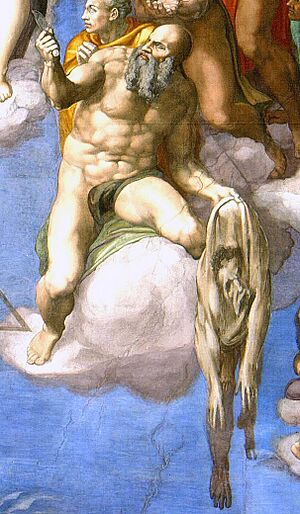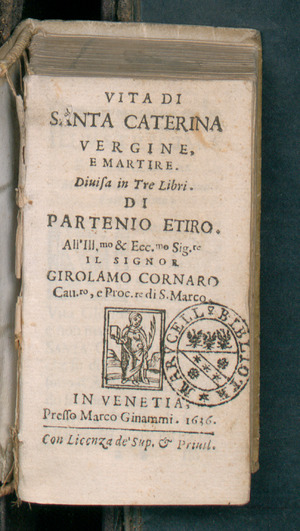Pietro Aretino facts for kids
Quick facts for kids
Pietro Aretino
|
|
|---|---|

Pietro Aretino, by Titian (Frick Collection)
|
|
| Born | 19 or 20 April 1492 Arezzo, Republic of Florence (present-day Tuscany, Italy) |
| Died | 21 October 1556 (aged 64) Venice, Republic of Venice (present-day Veneto, Italy) |
| Occupation |
|

Pietro Aretino (US: /ˌɑːrɪˈtiːnoʊ, ˌær-/, Italian: [ˈpjɛːtro areˈtiːno]; 19 or 20 April 1492 – 21 October 1556) was an Italian author, playwright, poet, satirist and blackmailer, who wielded influence on contemporary art and politics. He was one of the most influential writers of his time and an outspoken critic of the powerful. Owing to his communications and sympathies with religious reformers, he is considered to have been a Nicodemite Protestant.
Life
His father was Luca Del Tura, a shoemaker from Arezzo, in Tuscany, Italy, who abandoned his family to join the militia. The father later returned to Arezzo, finally dying in poverty at the age of 85, unforgiven by his son, who never acknowledged the paternal name, taking Aretino (meaning 'Arretine, from Arezzo') as a surname.
His mother was Margherita, known as Tita, Bonci. Either before or after the abandonment (it is not known which), she entered into a lasting relationship with a local noble, Luigi Bacci, who supported Tita, Pietro and his two sisters and brought up Pietro as part of his own family.
Aretino spent a formative decade in Perugia, before being sent, highly recommended, to Rome. There Agostino Chigi, the rich banker and patron of Raphael, took him under his wing.
When Hanno the elephant, pet of Pope Leo X, died in 1516, Aretino penned a satirical pamphlet entitled "The Last Will and Testament of the Elephant Hanno". The fictitious will cleverly mocked the leading political and religious figures of Rome at the time, including Pope Leo X himself. The pamphlet was such a success that it started Aretino's career and established him as a famous satirist, ultimately known as "the Scourge of Princes".
Aretino prospered, living from hand to mouth as a hanger-on in the literate circle of his patron, sharpening his satirical talents on the gossip of politics and the Papal Curia, and turning the coarse Roman pasquinade into a rapier weapon of satire.
After Leo's death in 1521, his patron was Cardinal Giulio de' Medici, whose competitors for the papal throne felt the sting of Aretino's scurrilous lash. The installation of the Dutch pope Adrian VI ("la tedesca tigna" in Pietro's words) instead encouraged Aretino to seek new patrons away from Rome, mainly with Federico II Gonzaga in Mantua, and with the condottiero Giovanni de' Medici ("Giovanni delle Bande Nere"). The election of his old Medici patron as Pope Clement VII sent him briefly back to Rome, but death threats and an attempted assassination from one of the victims of his pen, Bishop Giovanni Giberti, in July 1525, set him wandering through northern Italy in the service of various noblemen, distinguished by his wit, audacity and brilliant and facile talents, until he settled permanently in 1527, in Venice, the anti-Papal city of Italy, "seat of all vices", Aretino noted with gusto.
Writings
His literary talent, his clear and sparkling style, his varied observation of men and things, would have made him a considerable writer under any circumstances, destitute as he was of the power of conceiving a genuine work of art, such as a true dramatic comedy; and to the coarsest as well as the most refined malice he added a grotesque wit so brilliant that in some cases it does not fall short of that of Rabelais.
Apart from sacred texts and comedies such as La cortigiana and La talenta, Aretino is remembered above all for his letters, full of literary flattery that could turn to blackmail. They circulated widely in manuscript and he collected them and published them at intervals winning as many enemies as it did fame, and earned him the dangerous nickname Ariosto gave him: flagello dei principi ("scourge of princes"). In 1559, three years after Aretino's death, his entire oeuvre was listed in the papal Index of Prohibited Books.
La cortigiana is a brilliant parody of Castiglione's Il Cortegiano, and features the adventures of a Sienese gentleman, Messer Maco, who travels to Rome to become a cardinal. In mockery of Castiglione's advice on how to become the perfect courtier, a charlatan proceeds to teach Messer Maco how to behave as a courtier: he must learn how to deceive and flatter, and sit hours in front of the mirror.
Portrayals by artists
Aretino was a close friend of Titian's, who painted his portrait three times: a 1527 portrait in the Kunstmuseum Basel, a 1537 portrait in the Frick Collection, and a 1545 portrait in the Pitti Palace. Luba Freedman cites a fourth portrait, from "not later than 1535", but Xavier F. Salomon, chief curator at the Frick Collection, writes that "there is no evidence that it ever existed". Titian also portrayed Aretino as Pontius Pilate in his painting "Ecce Homo", in the Kunsthistorisches Museum, Vienna, "as a nameless soldier in the crowd" in "Alfonso d'Avalos Addressing his Troops", in the Prado Museum, Madrid, and next to a self-portrait in "La Gloria", also in the Prado. Clement VII made Aretino a Knight of Rhodes, and Julius III named him a Knight of St. Peter, but the chain he wears for his 1545 portrait may have merely been jewelry. In his strictly-for-publication letters to patrons Aretino would often add a verbal portrait to Titian's painted one.
Titian was far from the only artist who portrayed Aretino. "Probably no other celebrity of the cinquecento had his image reproduced so often and in so many media: paintings, frescoes, sculptures, prints, medals [...] At various stages of his life Aretino was also portrayed by Sebastiano del Piombo, Alessandro Moretto, Francesco Salviati, Jacopo Tintoretto, and Giorgio Vasari. His portrait was engraved by Marcantonio Raimondi and Giovanni Jacopo Caraglio. His likeness was reproduced on medals by Leone Leoni, Francesco Segala, Alfonso Lombardi, and Alessandro Vittoria and his image was sculpted by Jacopo Sansovino and Danese Cattaneo."
Works
Poetry
- Marfisa (1527–; published 1532, 1535)
- Angelica (published 1536)
- Orlandino (published 1540)
- Astolfeida (published c. 1547)
Prose
- Lettere
- Ragionamenti (also called Sei Giornate) (1534, 1536). A pair of Renaissance dialogues. In the Dialogue of Nanna and Antonia under a Fig Tree in Rome (1534), the two women discuss the life options open to Nanna's daughter, Pippa, to become a nun or a wife. Translated by Raymond Rosenthal as Aretino's Dialogues (New York: Stein and Day, 1972).
Plays
- Farza
- La cortigiana (1525, 1534). Comedy in five acts, a parody of the then-unpublished Il cortegiano by Baldassare Castiglione. First performance possibly in Carnival 1525. A revised version was published in Venice in 1534.
- Il marescalco (1533). Comedy in five acts. The play served as a source for Malipiero's opera of the same name (Treviso, 1969).
- La talanta (1542). Comedy in five acts.
- Lo ipocrito (1542). Comedy in five acts.
- Il filosofo (1546). Comedy in five acts.
- L'Orazia (1546). Tragedy in verse.
See also
 In Spanish: Pietro Aretino para niños
In Spanish: Pietro Aretino para niños




